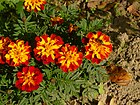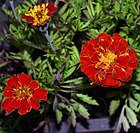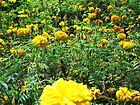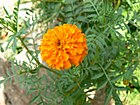Note: This is a project under development. The articles on this wiki are just being initiated and broadly incomplete. You can Help creating new pages.
Tagetes erecta
African marigold is an aromatic, erect, annual plant that can grow up to 180cm tall, but is more likely to be around 25cm. The plant has a wide range of medicinal uses. It is also used as a flavouring in food, a popular dye plant and is an effective repellent. It is cultivated as a dye plant in the Americas, and is widely cultivated in temperate to tropical regions as an ornamental plant. This plant is belongs to Asteraceae family.
Contents
[hide]- 1 Uses
- 2 Parts Used
- 3 Chemical Composition
- 4 Common names
- 5 Properties
- 6 Habit
- 7 Identification
- 8 List of Ayurvedic medicine in which the herb is used
- 9 Where to get the saplings
- 10 Mode of Propagation
- 11 How to plant/cultivate
- 12 Commonly seen growing in areas
- 13 Photo Gallery
- 14 References
- 15 External Links
Uses
Indigestion, Colic, Severe constipation, Coughs, Dysentery, Sores, Ulcers, Eczema, Sore eyes, Rheumatism, Boils.[1]
Parts Used
Chemical Composition
Twenty five compounds were identified in the oil of T. erecta, of which linalool (22.5 %), 2-hexyl-l-decanol (18.3 %), piperitone (13.4 %), 4-terpinyl acetate (7.8 %) and caryophyllene (6.6 %) are the main components.[2]
Common names
| Language | Common name |
|---|---|
| Kannada | Chendu hu, Gondegida |
| Hindi | Genda |
| Malayalam | |
| Tamil | Turukkasamandi |
| Telugu | Banti |
| Marathi | |
| Gujarathi | |
| Punjabi | |
| Kashmiri | |
| Sanskrit | Janduga, Sthulapushpa |
| English | African merregold |
Properties
Reference: Dravya - Substance, Rasa - Taste, Guna - Qualities, Veerya - Potency, Vipaka - Post-digesion effect, Karma - Pharmacological activity, Prabhava - Therepeutics.
Dravya
Rasa
Guna
Veerya
Vipaka
Karma
Prabhava
Habit
Identification
Leaf
| Kind | Shape | Feature |
|---|---|---|
Flower
| Type | Size | Color and composition | Stamen | More information |
|---|---|---|---|---|
| {{{5}}} |
Fruit
| Type | Size | Mass | Appearance | Seeds | More information |
|---|---|---|---|---|---|
Other features
List of Ayurvedic medicine in which the herb is used
Where to get the saplings
Mode of Propagation
How to plant/cultivate
Requires a well-drained moderately fertile soil in a sunny position. Grows well in heavy clay soils and in sandy soils.[5]
Commonly seen growing in areas
Pine-oak forest zone, Dry thickets, On waste ground.
Photo Gallery
References
- Jump up ↑ Indian Medicinal Plants by C.P.Khare
- Jump up ↑ Chemical constituents
- Jump up ↑ Karnataka Aushadhiya Sasyagalu By Dr.Maagadi R Gurudeva, Page no:137
- Jump up ↑ [Morphology]
- Jump up ↑ Cultivation
External Links
- Ayurvedic Herbs known to be helpful to treat Indigestion
- Ayurvedic Herbs known to be helpful to treat Colic
- Ayurvedic Herbs known to be helpful to treat Severe constipation
- Ayurvedic Herbs known to be helpful to treat Coughs
- Ayurvedic Herbs known to be helpful to treat Dysentery
- Ayurvedic Herbs known to be helpful to treat Sores
- Ayurvedic Herbs known to be helpful to treat Ulcers
- Ayurvedic Herbs known to be helpful to treat Eczema
- Ayurvedic Herbs known to be helpful to treat Sore eyes
- Ayurvedic Herbs known to be helpful to treat Rheumatism
- Ayurvedic Herbs known to be helpful to treat Boils
- Herbs with Leaves used in medicine
- Herbs with Flowers used in medicine
- Herbs with common name in Kannada
- Herbs with common name in Hindi
- Herbs with common name in Tamil
- Herbs with common name in Telugu
- Herbs with common name in Sanskrit
- Herbs with common name in English
- Habit - Annual
- Index of Plants which can be propagated by Seeds
- Herbs that are commonly seen in the region of Pine-oak forest zone
- Herbs that are commonly seen in the region of Dry thickets
- Herbs that are commonly seen in the region of On waste ground
- Herbs





